Optimizing Nitrogen Fertilization and Irrigation Practices for Enhanced Winter Wheat Productivity in the North China Plain: A Meta-Analysis
Abstract
1. Introduction
2. Results
2.1. Literature Screening and Study Characterstics
2.2. Meta-Analysis of Water–Nitrogen Coupling Effect
2.2.1. Comprehensive Effect Analysis Using Meta-Analysis
2.2.2. Heterogeneity Analysis
2.2.3. Subgroup Analysis
2.2.4. Sensitivity Analysis
2.3. Field Experiment Results of Water–Nitrogen Coupling Effect
2.3.1. Water–Nitrogen Coupling Effect on Winter Wheat Growth and Physiological Indices and Soil Physicochemical Properties
2.3.2. Water–Nitrogen Coupling Effect on Yield and Water Nitrogen Utilization Efficiency
2.3.3. Correlation Analysis of Climate Environment, Soil, and Yield Under Different Nitrogen Fertilizer Combinations
3. Discussion
3.1. Water–Nitrogen Synergy Maintained Yield While Increasing WUE and PUE
3.2. Water and Nitrogen Coupling Effect Shows Significant Regional Differences
3.3. Precise Management of Water and Nitrogen Promotes Sustainable Agricultural Development
4. Materials and Methods
4.1. Study Area Description and Data Retrieval Strategy
4.2. Data Extraction
4.3. Data Calculation
4.4. Bias Risk Assessment
4.5. Statistical Analysis
5. Conclusions
Author Contributions
Funding
Data Availability Statement
Acknowledgments
Conflicts of Interest
References
- Ma, M.; Song, S.; Xu, Y.; Chen, X.; Yu, W. Analysis of Energy Balance Characteristics and Meteorological Influence Factors of Winter Wheat Farmland in North China Plain. Meteorol. Environ. Sci. 2024, 47, 47–54. [Google Scholar]
- Peng, Q. Spatiotemporal Evolution Characteristics of Flash Droughts and Risk Assessment of Winter Wheat Drought in the North China Plain. Ph.D. Thesis, Northwest A&F University, Yangling, China, 2024. [Google Scholar]
- Yang, T.; Wang, J.; Zhang, H.; Li, R.; Zhang, Y.; Shen, Y. Evapotranspiration of typical agroecosystems in the North China Plain based on single crop coefficient method. Chin. J. Eco-Agric. 2022, 30, 356–366. [Google Scholar]
- Hou, Y. Effects of Drip Irrigation Water and Fertilizer Regulation on Winter Wheat Growth and Water-Fertilizer Use Efficiency in the North China Plain. Ph.D. Thesis, Hebei Agricultural University, Baoding, China, 2022. [Google Scholar]
- Guan, C.; Duan, Y.; Liu, F.; Luo, L.; Zhu, H.; Wang, X. Effects of Irrigation Methods and Nitrogen Management on Yield and Nitrogen Use Efficiency of Double-Cropping Late Rice. Acta Agric. Boreali-Sin. 2024, 39, 139–148. [Google Scholar]
- Liu, C.; Shang, J. Research Status and Development Trends of Carbon Emissions in Grain Life Cycle. Chin. J. Agrometeorol. 2024, 45, 1131–1145. [Google Scholar]
- Liao, L. Effects of Fertilizer Types and Nitrogen Application rates on Spring Maize Yield, Water-Nitrogen Use and Carbon Footprint. Ph.D. Thesis, Northwest A&F University, Yangling, China, 2024. [Google Scholar]
- Wang, F.; Guo, Y.; Li, P.; Wei, J.; Fan, Z.; Hu, F.; Fan, H.; He, W.; Yin, W.; Chen, G. Compensation Mechanism of Increased Density on Yield of Water-Nitrogen Reduced Maize in Oasis Irrigation Area. Acta Agron. Sin. 2024, 50, 1616–1627. [Google Scholar]
- Wei, H. Effects of Pipe-Channel Irrigation and Nitrogen Application Rate on Winter Wheat Yield and Water-Nitrogen Use Efficiency. Ph.D. Thesis, Shandong Agricultural University, Tai’an, China, 2023. [Google Scholar]
- Liu, J.; Ning, D.; Qin, A.; Zhang, J.; Liu, Z.; Sun, B.; Ding, P.; Li, F.; Shen, H.; Zhao, D. Study on Grain-Filling Characteristics and Water-Nitrogen Optimal Coupling of Sprinkler Irrigated Winter Wheat in Southern Huang-Huai Plain. J. Soil Water Conserv. 2021, 35, 244–250. [Google Scholar]
- Dercas, N.; Dalezios, N.R.; Stamatiadis, S.; Evangelou, E.; Glampedakis, A.; Mantonanakis, G.; Tserlikakis, N. AquaCrop Simulation of Winter Wheat under Different N Management Practices. Hydrology 2022, 9, 56. [Google Scholar] [CrossRef]
- Zhang, J.; Ma, N.; Zhang, Y.; Guo, Y. Changes in Water Surplus or Deficit and Possible Drivers in the North China Plain During 1961–2022. Int. J. Climatol. 2024, 44, 5761–5772. [Google Scholar] [CrossRef]
- Shu, J.; Bai, Y.; Chen, Q.; Weng, C.; Zhang, F. Dynamic simulation of the water-land-food nexus for the sustainable agricultural development in the North China Plain. Sci. Total Environ. 2024, 912, 168771. [Google Scholar] [CrossRef]
- Jiang, Z.; Zhu, J.; Guo, H.; Qiu, K.; Tang, M.; Yang, X.; Liu, J. South-to-North Water Diversion Halting Long-Lived Subsidence in Tianjin, North China Plain. Remote Sens. 2024, 16, 3213. [Google Scholar] [CrossRef]
- Marimuthu, S.; Kannan, S.V.; Pazhanivelan, S.; Geethalakshmi, V.; Raju, M.; Sivamurugan, A.; Karthikeyan, M.; Byrareddy, V.; Mushtaq, S.; Surendran, U. Harnessing rain hose technology for water-saving sustainable irrigation and enhancing blackgram productivity in garden land. Sci. Rep. 2024, 14, 18692. [Google Scholar] [CrossRef]
- Yu, J. Research on the application of water measuring technology in water-saving irrigation. Appl. Math. Nonlinear Sci. 2024, 9, 1. [Google Scholar] [CrossRef]
- Fan, Y.; Feng, Q.; Huang, Y.; Yang, N.; Fan, H.; Li, B.; Wang, X.; Yang, L.; Yen, H.; Wu, F. Determining optimal range of reduction rates for nitrogen fertilization based on responses. Sci. Total Environ. 2024, 924, 171523. [Google Scholar] [CrossRef] [PubMed]
- Yin, C.; Li, L.; Zhao, J.; Yang, J.; Zhao, H. Impacts of Returning Straw and Nitrogen Application on the Nitrification and Mineralization of Nitrogen in Saline Soil. Water 2023, 15, 564. [Google Scholar] [CrossRef]
- Yuan, Y.; Long, R.; Tao, J.; Wang, Q.; Li, S. Effect of Amount and Method of Irrigation and Fertilization on Yield and Quality of Spinach. J. Irrig. Drain. 2023, 42, 19–24. [Google Scholar]
- Zhou, X.; Lv, T.; Xing, M.; Song, R.; Fu, X. The Combined Effect of Irrigation and Fertilization on Yield and Quality of Fruits of Chinese Date. J. Irrig. Drain. 2023, 42, 45–51. [Google Scholar]
- Chaiwong, N.; Promuthai, C.; Ostlie, M. Yield and Grain Quality Response of Spring Wheat Varieties to Irrigation and Fertility Management. Agric. Sci. 2023, 14, 939–953. [Google Scholar] [CrossRef]
- Ayas, S. Different irrigation and fertilization levels and mulching materials on the yield and quality of strawberry. Ciênc. Agrotechnol. 2023, 47, e014122. [Google Scholar] [CrossRef]
- Wu, Q.; Wu, Q.; Deng, C.; Liu, K.; Qi, D.; Zhu, J. The Effect of Controlled Drainage and Nitrogen Fertilization on Growth, Nitrogen Uptake and Yield of Cotton. J. Irrig. Drain. 2023, 42, 32–38. [Google Scholar]
- Feyisa, H.; Mengistu, G.; Biri, A.; Chimdessa, T. Grain Yield and Yield Related Traits of Bread Wheat as Influenced by N and Seeding rates. Int. J. Agron. 2023, 2023, 8666699. [Google Scholar]
- Lei, Q.; Tao, W.; Lin, S.; Su, L.; Deng, M.; Wang, Q.; Yang, F.; Zhu, T.; Ma, L. The Synergistic Production Effect of Water and Nitrogen on Winter Wheat in Southern Xinjiang. Plants 2024, 13, 1391. [Google Scholar] [CrossRef] [PubMed]
- Canavari, M.; Caggiati, P.; Easter, K.W. Economic Studies on Food, Agriculture, and the Environment; Springer: New York, NY, USA, 2002. [Google Scholar]
- Chow, A.T.; Tanji, K.K.; Gao, S.; Dahlgren, R.A. Temperature, water content and wet–dry cycle effects on DOC production and carbon mineralization in agricultural peat soils. Soil Biol. Biochem. 2006, 38, 477–488. [Google Scholar] [CrossRef]
- Maeda, M.; Ihara, H.; Ota, T. Deep-soil adsorption of nitrate in a Japanese andisol in response to different nitrogen sources. Soil Sci. Soc. Am. J. 2008, 72, 702–710. [Google Scholar] [CrossRef]
- Liu, T.; Ma, L.; Wang, S.; Liu, Y.; Wang, D.; Zhao, Y.; Li, K. Effects of Water and Nitrogen Supply Under Different Irrigation Methods on Water and Nitrogen Use Efficiency of Winter Wheat. J. Irrig. Drain. 2024, 43, 11–18. [Google Scholar]
- Zhen, Y.; Xu, L.; Gao, H. Effects of Water-Nitrogen Coupling on Water and Nitrogen Use Efficiency of Subsurface Drip-Irrigated Winter Wheat and Summer Maize. J. Irrig. Drain. 2024, 43, 41–49. [Google Scholar]
- Ding, B.; Zhang, X.; Zhao, Z.; Hou, Y. Meta-Analysis of Yield and Water Use Efficiency Changes of Winter Wheat Under Limited Irrigation Conditions in the North China Plain. J. Irrig. Drain. 2021, 40, 7–17. [Google Scholar]
- Zhao, W.; Zhang, M.; Zhu, C.; Li, J.; Huang, Q. Winter Wheat Yield and Water-Saving Effects Based on Variable Irrigation Dynamic Zoning Management. Trans. Chin. Soc. Agric. Eng. 2024, 40, 109–117. [Google Scholar]
- Xing, S.; Yang, W.; Yang, J.; Nie, H.; Yang, H.; Zhang, J.; Ren, Y.; Wang, J.; Zhang, J.; Huang, S. Effects of Different Micro-Irrigation and Fertilization Modes on Yield and Benefit of Winter Wheat. Hebei Agric. Sci. 2023, 27, 45–51+81. [Google Scholar]
- Li, B.; Wang, G.; Chen, Z.; Xue, J.; Chen, Z.; Gong, Y.; Zhang, J.; Duan, W. Effects of Layered Fertilization on Yield and Water Use Efficiency of Winter Wheat Under Different Irrigation Conditions. J. Soil Water Conserv. 2021, 35, 326–332. [Google Scholar]
- Lu, J.; Hu, T.; Li, Y.; Cui, X.; Cheng, M.; Yan, S.; Xiang, Y.; Fan, J.; Zhang, F.; Xiong, Y. Effects of different water management strategies on critical nitrogen concentration dilution curves, nitrogen accumulation, and grain yield in winter wheat. Agric. Commun. 2024, 2, 100052. [Google Scholar] [CrossRef]
- Wang, Y.; Sun, H.; Wang, L. Optimizing drip irrigation to enhance winter wheat performance: Yield, economic benefits, and water use efficiency. Int. J. Agric. Sustain. 2024, 22, 1. [Google Scholar] [CrossRef]
- Chen, H.; Huang, C.; Liu, X.; Gong, W.; Sun, M.; Zhang, Y.; Wang, X.; Liu, Z. Effects of irrigation methods and fertilizer combinations on winter wheat growth and fertilizer utilization. J. Irrig. Drain. 2023, 42, 31–38. [Google Scholar]
- Huang, X.; Xu, X.; Zhu, Q.; Zhang, Y. Optimizing water and nitrogen inputs for sustainable wheat yields and minimal environmental impacts. Agric. Syst. 2024, 220, 104061. [Google Scholar] [CrossRef]
- Feng, S.; Shi, C.; Wang, P.; Chang, S.; Hu, T.; Ru, Z. Stem characteristics and yield of wheat is regulated to improve planting efficiency and reduce lodging risk by fertilizer rate and irrigation stage. Agric. Water Manag. 2024, 306, 109192. [Google Scholar] [CrossRef]
- Cui, Z.; Yu, Z.; Shi, Y.; Zhang, Y.; Zhang, Z. Effects of water and nitrogen management on photosynthetic matter production and yield of wheat. Chin. J. Appl. Ecol. 2024, 35, 1564–1572. [Google Scholar]
- Zhao, J.; Xu, X.; Liu, S.; Jia, J.; Li, M.; Huang, H.; Zhang, G.; Zhao, C. Optimizing wheat prosperity: Innovative drip irrigation and nitrogen management strategies. Front. Plant Sci. 2024, 15, 1454205. [Google Scholar] [CrossRef] [PubMed]
- He, P.; Yu, S.; Ding, J.; Ma, T.; Li, J.; Dai, Y.; Chen, K.; Peng, S.; Zeng, G.; Guo, S. Multi-objective optimization of farmland water level and nitrogen fertilization management. Agric. Water Manag. 2024, 297, 108840. [Google Scholar] [CrossRef]
- Jin, Y.; Chen, H.; Tang, X.; Zhang, L.; Yan, J.; Li, S.; Chen, Y.; Li, X.; Wu, H.; Xiao, X. Combination of nitrogen and organic fertilizers reduce N2O emissions while increasing winter wheat grain yields and quality in China. Front. Environ. Sci. 2024, 12, 1485043. [Google Scholar] [CrossRef]
- Vogeler, I.; Kumar, U.; Knudsen, L.; Hansen, E.; Snow, V.; Thomsen, I. Development of Algorithm for Determining N Fertiliser Requirements of Winter Wheat Based on N Status Using APSIM Modelling. Crops 2024, 4, 134–144. [Google Scholar] [CrossRef]
- Yan, Z.; Zhang, W.; Liu, X.; Wang, Q.; Liu, B.; Mei, X. Grain yield and water productivity of winter wheat controlled by irrigation regime and manure substitution in the North China Plain. Agric. Water Manag. 2024, 295, 108731. [Google Scholar] [CrossRef]
- Bao, X.; Zhang, B.; Dai, M.; Liu, X.; Ren, J.; Gu, L.; Zhen, W. Improvement of grain weight and crop water productivity in winter wheat by light and frequent irrigation based on crop evapotranspiration. Agric. Water Manag. 2024, 301, 108922. [Google Scholar] [CrossRef]
- Hai, F.; Zhang, Y.; Xie, X.; Lv, X.; Chen, C.; Xu, Q.; Nie, S.; Wang, J.; Lei, J. Effects of different drip irrigation amounts on photosynthetic characteristics and yield of winter wheat under limited irrigation. Xinjiang Agric. Sci. 2025, 62, 45–52. [Google Scholar]
- Abubakar, S.A.; Hamani, A.K.M.; Wang, G.; Liu, H.; Mehmood, F.; Abdullahi, A.; Gao, Y.; Duan, A. Growth and nitrogen productivity of drip-irrigated winter wheat under different nitrogen fertigation strategies in the North China Plain. J. Integr. Agric. 2023, 22, 908–922. [Google Scholar] [CrossRef]
- Gu, Q.; Liu, Y.; Feng, M.; Li, J.; Li, L.; Wan, X.; Liu, S.; Shi, C. Effects of water-nitrogen coupling under drip irrigation on yield components and water-fertilizer use efficiency of winter wheat in different soil types. Shandong Agric. Sci. 2021, 53, 47–55. [Google Scholar]
- Kang, X.; Ma, A.; Jing, H.; Zhao, Y.; Cui, H.; Xi, J.; Huang, X. Effects of micro-sprinkling limited irrigation on yield and water-nitrogen use efficiency of winter wheat. Acta Agron. Sin. 2024, 50, 3107–3117. [Google Scholar] [CrossRef]
- Xuan, Z.; Zhang, X.; Dang, H.; Niu, J. Optimization of winter wheat irrigation schedule in Hebei Plain based on AquaCrop model. J. Irrig. Drain. 2025, 44, 10–19. [Google Scholar]
- Mostafa, E.; Emara, E.; Bakr, R.; Abdel Azim, K.; Mohamed Hamed, L. Enhancing wheat productivity utilizing nano- and bio-fertilizers in water-scarce Sinai, Egypt, under different irrigation systems. Water Sci. 2024, 38, 209–224. [Google Scholar] [CrossRef]
- Zhang, X.; Zhang, J.; Li, L.; Liu, Y.; Zhen, W.; Wang, G. Interaction effects of water and nitrogen practices on wheat yield, water and nitrogen productivity under drip fertigation in Northern China. Agriculture 2024, 14, 1496. [Google Scholar] [CrossRef]
- Babichev, A.N.; Sidarenko, D.P. Effects of precision irrigation on water regime and productivity of winter wheat. RUDN J. Agron. Anim. Ind. 2023, 18, 554–565. [Google Scholar] [CrossRef]
- Guo, X.; Xie, J.; Xiao, J. Effects of different water and fertilizer treatments with Yellow River water drip irrigation on winter wheat growth and water-fertilizer utilization efficiency. Water Sav. Irrig. 2023, 2, 12–19. [Google Scholar]
- Cong, X.; Zhang, L.; Xu, Z.; Pang, G.; Feng, Y.; Zhao, D. Effects of irrigation and nitrogen interaction on water and fertilizer use efficiency and economic benefits of winter wheat. Trans. Chin. Soc. Agric. Mach. 2021, 52, 315–324. [Google Scholar]
- Zhang, Z.; Li, M.; Yang, Z.; Cai, Z.; Hong, T.; Ding, M. Comprehensive regulation of water and fertilizer coupling based on multi-index collaboration of strawberry. Trans. Chin. Soc. Agric. Mach. 2020, 51, 267–276. [Google Scholar]
- Li, X.; Ding, Z.; Yan, J.; Guo, Y.; Leng, X.; Wang, M. Interaction effect and model of water and nitrogen under degradable film mulching in drip irrigated sandy farmland. Trans. Chin. Soc. Agric. Mach. 2018, 49, 261–270. [Google Scholar]
- Yang, J.; Ma, J.; Ma, L.; Xu, W.; Ji, Y.; Wang, L.; Feng, Y.; Feng, Z. Combination of water-saving irrigation and controlled-release fertilizer application reduced gaseous nitrogen loss in single-crop paddy soil. J. Environ. Manag. 2025, 377, 124695. [Google Scholar]
- Liu, J.; Fan, X.; Li, X.; Zheng, Y.; Li, Y.; Cui, C.; Bai, Z.; Ma, L.; Zhai, B.; Li, Z. Responses of different agricultural structures to nitrogen loss and agricultural green development in Northwest China. Agric. Ecosyst. Environ. 2024, 367, 108956. [Google Scholar] [CrossRef]
- He, P. Comprehensive Evaluation of the Effects of Different Water and Fertilizer Patterns on Physiological Growth and Soil Nutrients in Winter Wheat. Ph.D. Thesis, North China University of Water Resources and Electric Power, Zhengzhou, China, 2023. [Google Scholar]
- Li, L.; Wang, Y.; Liu, F. Alternate partial root-zone N-fertigation increases water use efficiency and N uptake of barley at elevated CO2. Agric. Water Manag. 2021, 258, 107168. [Google Scholar] [CrossRef]
- Lian, Y.; Zhang, X.; Du, F.; Zhang, X.; Ali, S. Mulch drip fertigation with diverse tillage practices regulating root bleeding sap, root growth, lodging resistance and improve maize productivity. Agric. Water Manag. 2024, 306, 109186. [Google Scholar] [CrossRef]
- Lin, S.; Wang, Q.; Deng, M.; Su, L.; Wei, K.; Guo, Y.; Zhang, J. Assessing the influence of water fertilizer, and climate factors on seed cotton yield under mulched drip irrigation in Xinjiang agricultural regions. Eur. J. Agron. 2024, 152, 127034. [Google Scholar] [CrossRef]
- Song, Y. Effects of Increasing Organic Fertilizer on Soil Aggregate Performance and Winter Wheat Yield Formation in Lime Concretion Black Soil Under Different Nitrogen Application Rates. Ph.D. Thesis, Henan Agricultural University, Zhengzhou, China, 2024. [Google Scholar]
- Qu, R. Study on Precision Application of Nitrogen on High Yield of Winter Wheat—Summer Maize. Ph.D. Thesis, Shandong Agricultural University, Taian, Chian, 2007. [Google Scholar]
- Guo, X.; Liu, P.; Wang, R.; Wang, X.; Li, J. Response of winter wheat yield, nitrogen use efficiency and soil nitrogen balance to rainfall types and nitrogen application rate in dryland. Acta Agron. Sin. 2022, 48, 1262–1272. [Google Scholar] [CrossRef]
- Skinner, C.; Garringer, A.; Muller, A.; Mader, P.; Fliessbach, A.; Stolze, M.; Ruser, R.; Niggli, U. Greenhouse gas fluxes from agricultural soils under organic and non-organic management: A global meta-analysis. Sci. Total Environ. 2014, 468, 553–563. [Google Scholar] [CrossRef]
- Liu, C.; Lu, M.; Cui, J.; Li, B.; Fang, C. Effects of straw carbon input on carbon dynamics in agricultural soils: A meta-analysis. Glob. Change Biol. 2014, 20, 1366–1381. [Google Scholar] [CrossRef] [PubMed]
- Wallace, B.; Lajeunesse, M.; Dietz, D.; Trikalinos, I.; Schmid, T. OpenMEE: Intuitive, open-source software for meta-analysis in ecology and evolutionary biology. Methods Ecol. Evol. 2017, 8, 941–947. [Google Scholar] [CrossRef]
- Breiman, L. Random forests. Mach. Learn. 2001, 45, 5–32. [Google Scholar] [CrossRef]
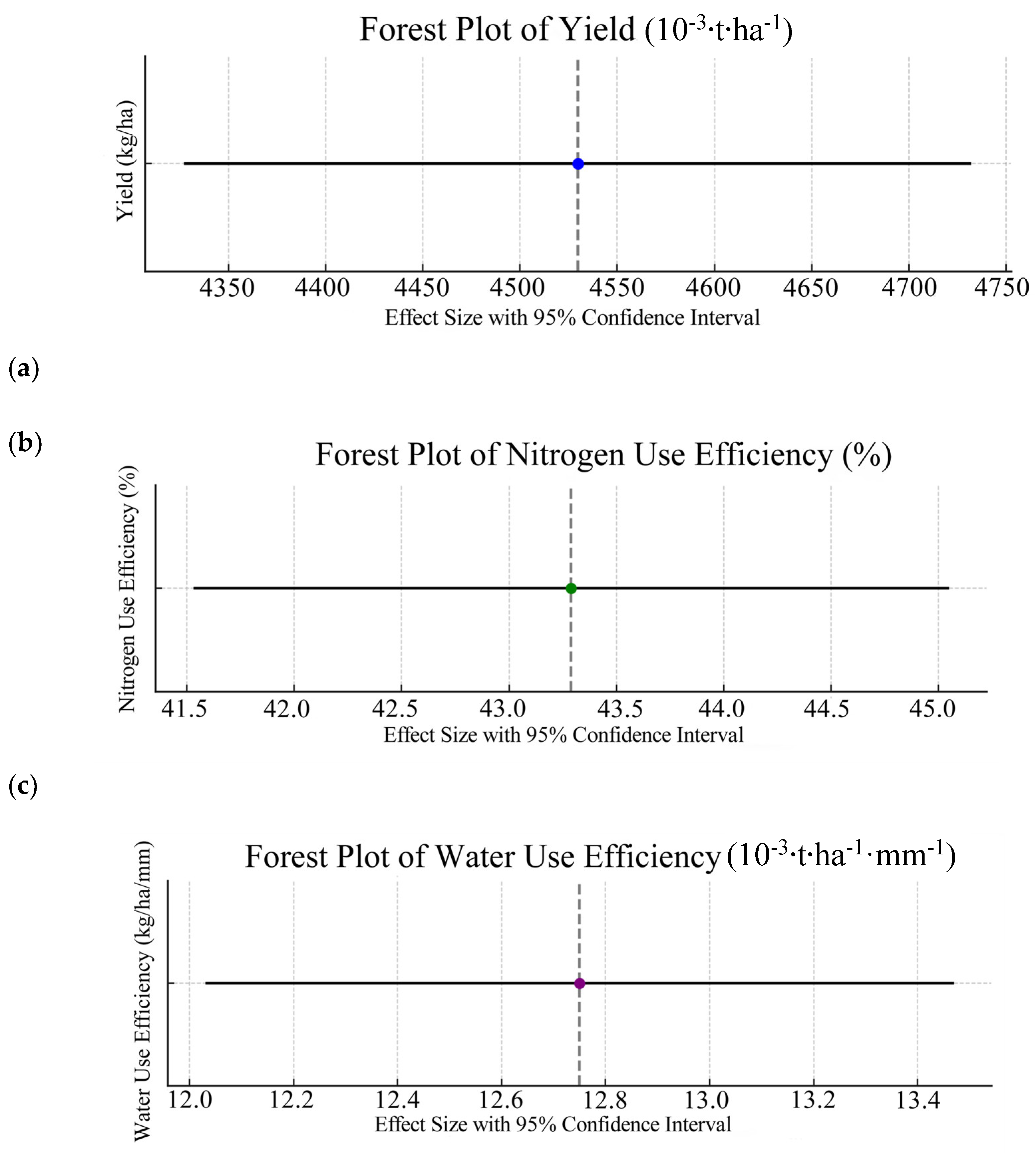
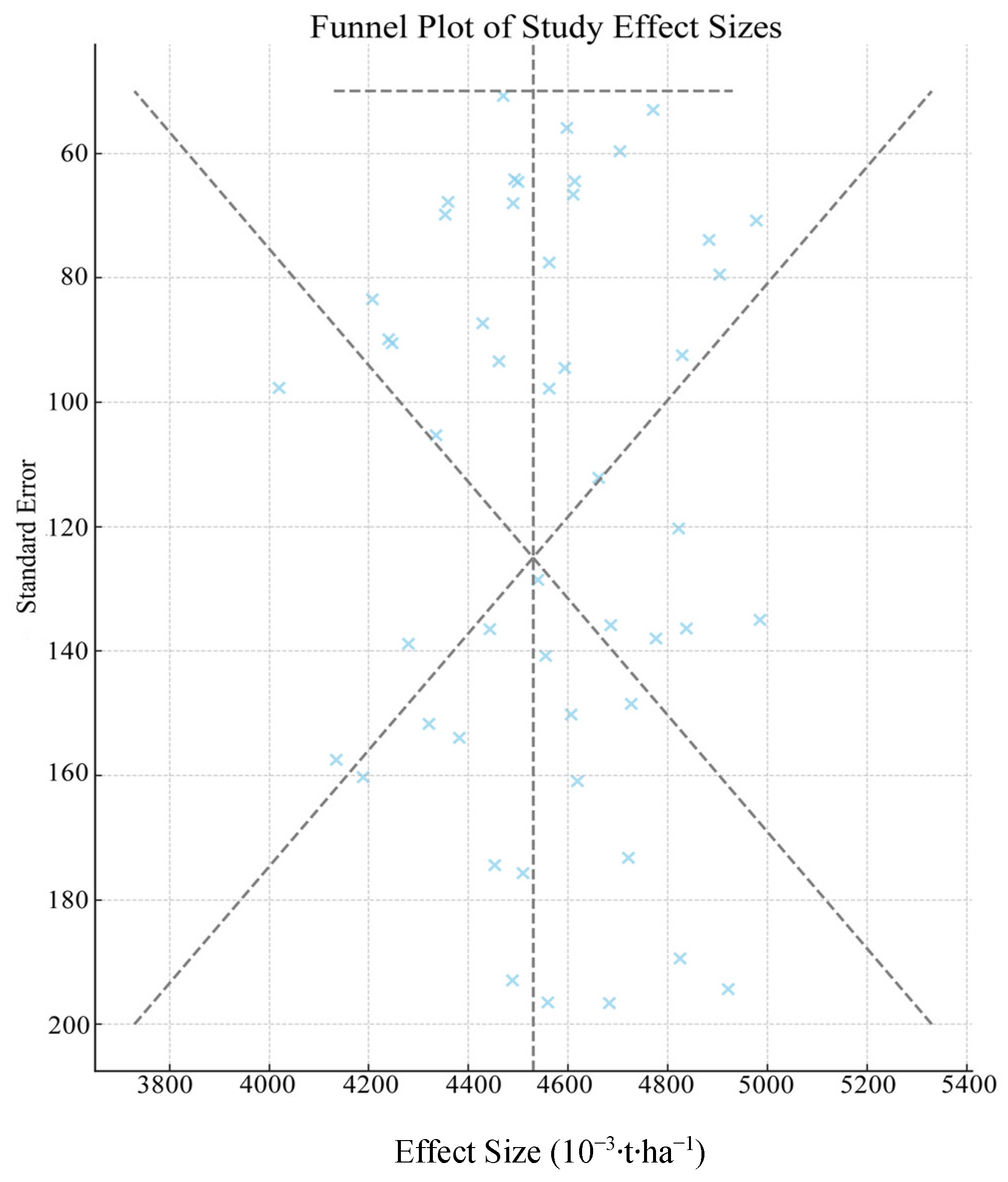
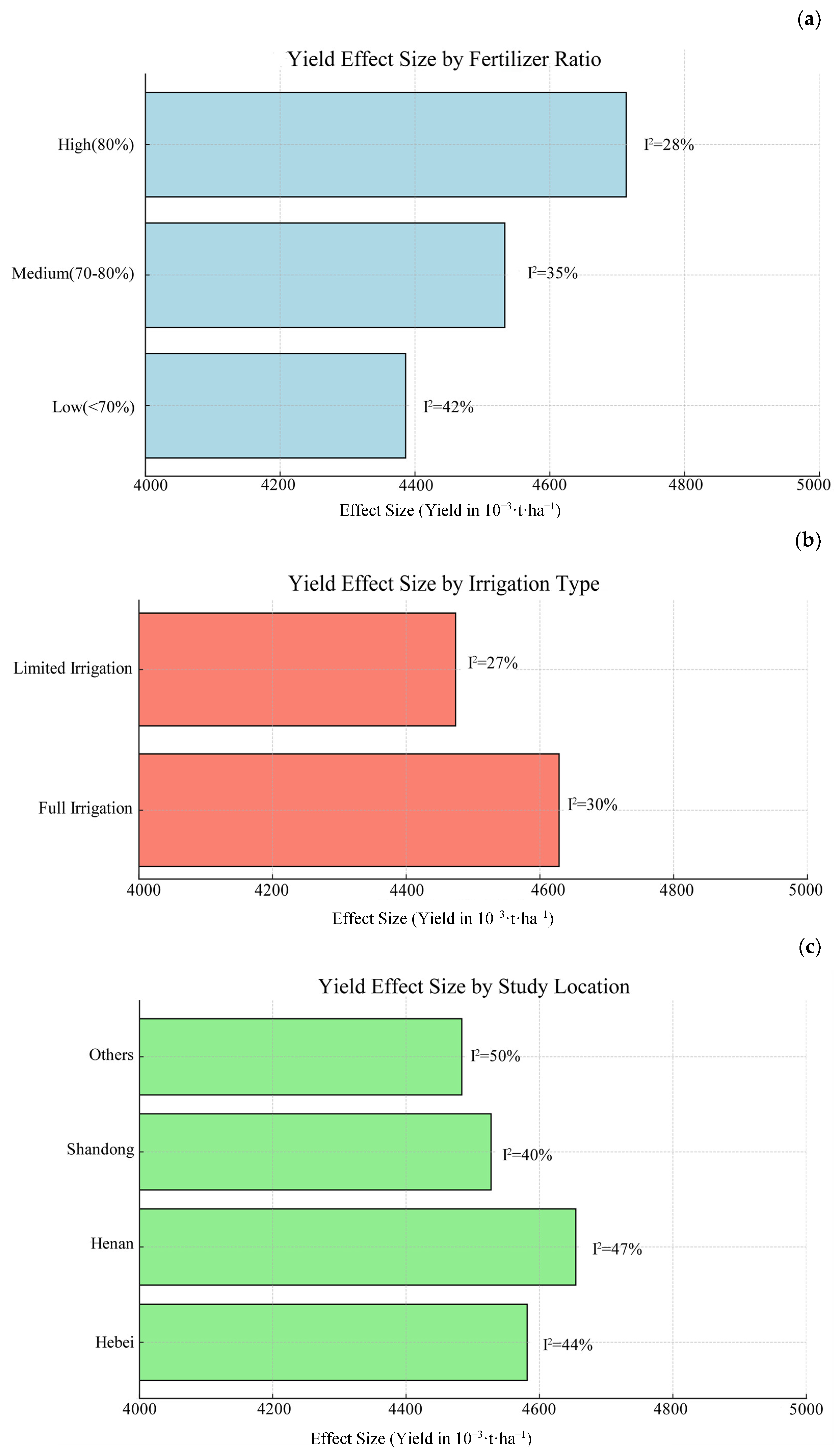
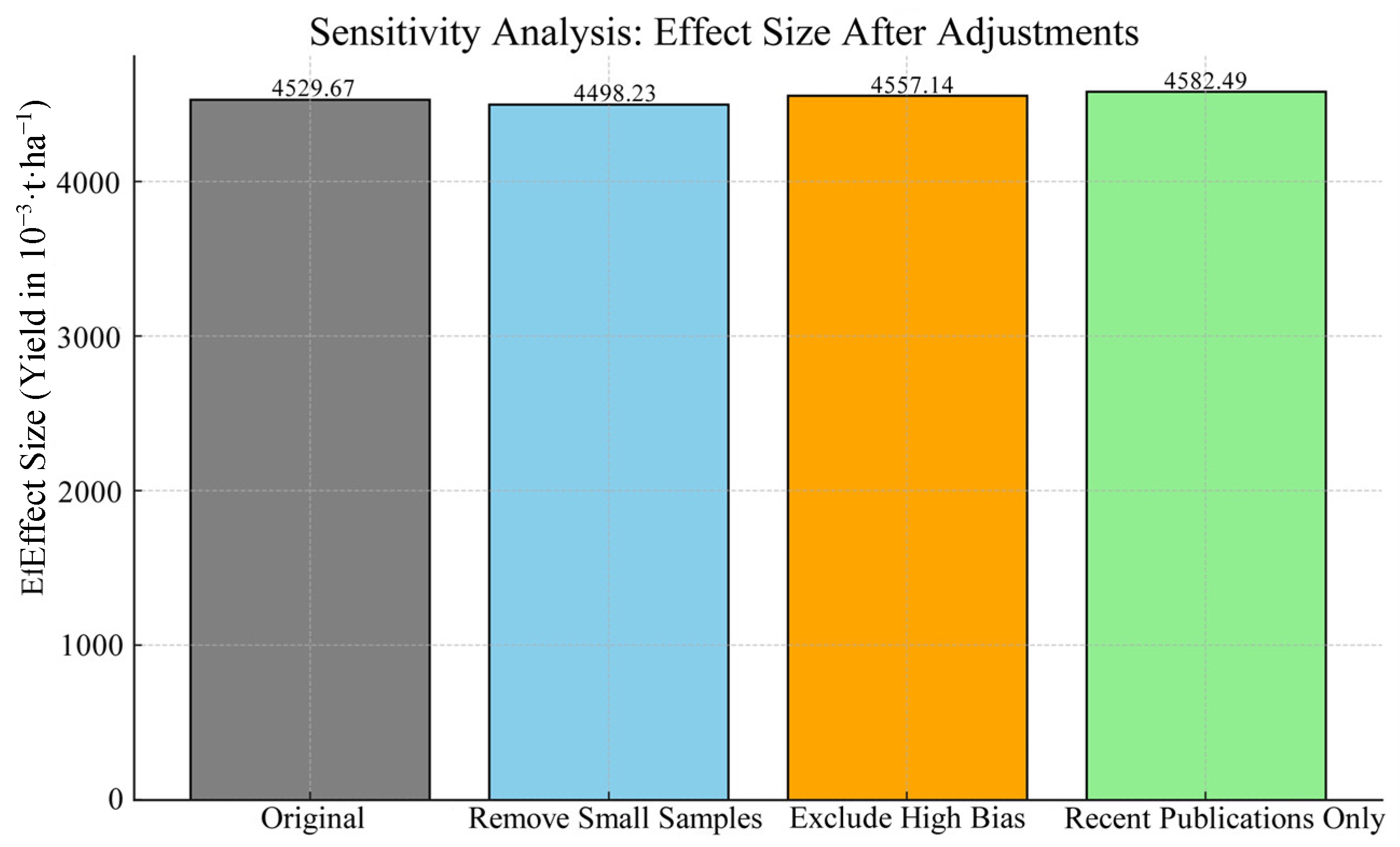
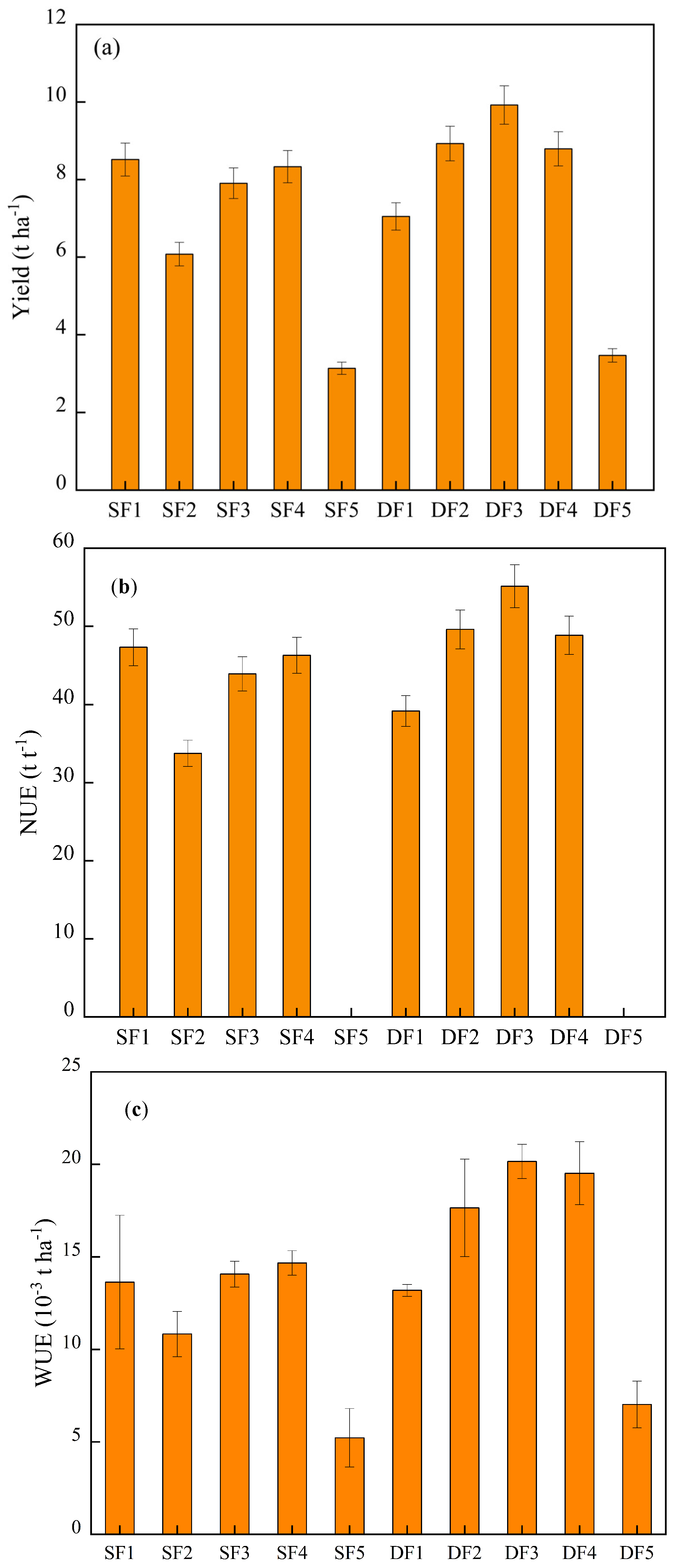
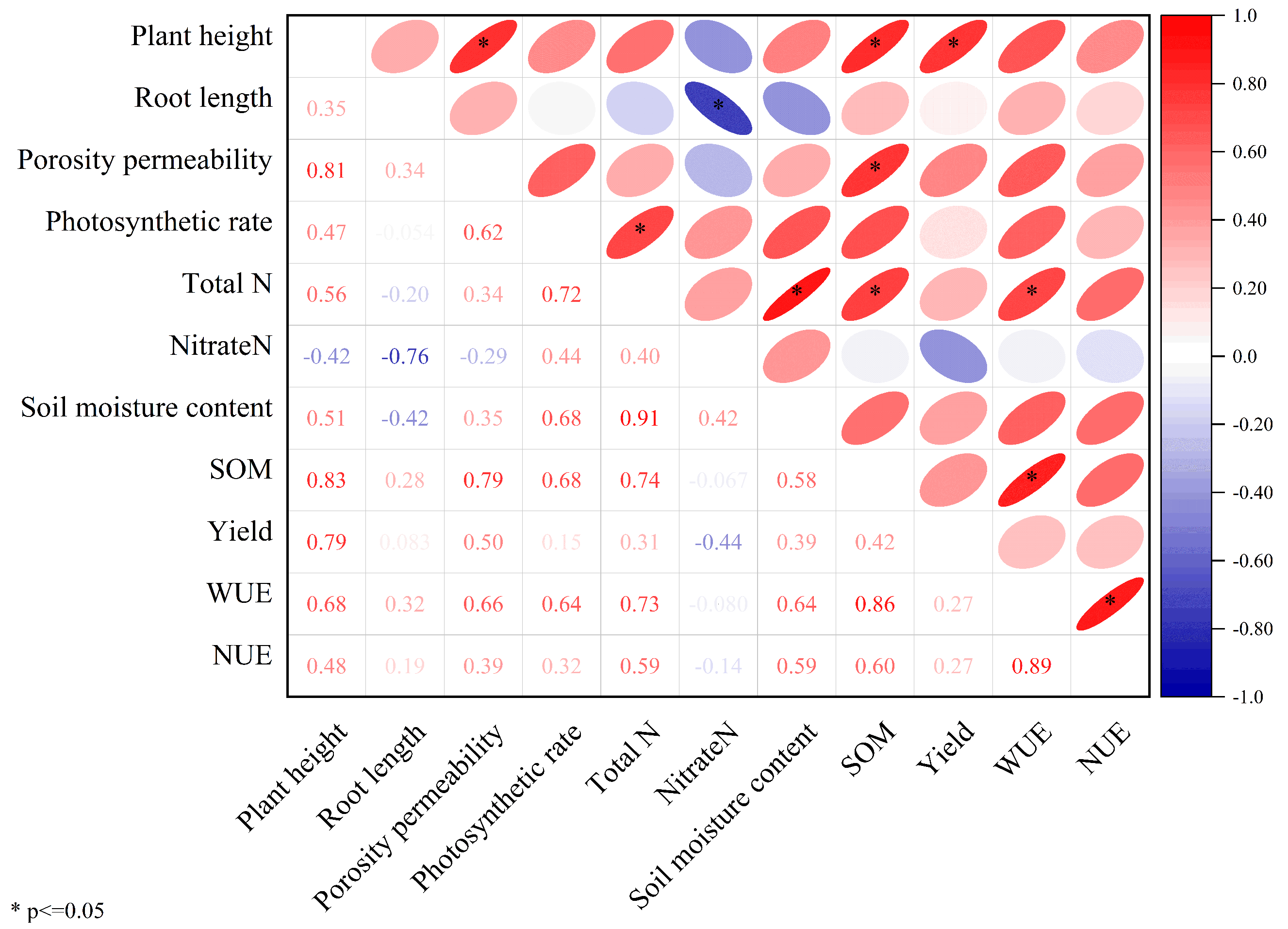

| Step | Number of Articles | Exclusion Reasons |
|---|---|---|
| Initial Search Results | 1238 | Not applicable |
| After Duplicate Removal | 958 | Duplicate records removed |
| After Title/Abstract Screening | 476 | Studies unrelated to the research topic or geographic region (North China Plain) |
| After Full-Text Review | 182 | Studies with incomplete data or lacking key variables (e.g., yield, NUE, WUE) |
| Included in Meta-Analysis | 94 | Studies meeting all inclusion criteria and providing sufficient data for analysis |
| Study No. | Author (Year) | Sites | Sample Size | Nitrogen Fertilizer Ratio (%) | Irrigation Method | Consecutive Years | Yield (t·ha−1) | Nitrogen Use Efficiency (%) | Water Use Efficiency (t·ha−1·mm−1) |
|---|---|---|---|---|---|---|---|---|---|
| S101 | Li et al. (2021) [34] | Hebei | 154 | 70 | Sufficient Irrigation | 2 | 4.23 | 42 | 0.012 |
| S102 | Wang et al. (2024) [36] | Henan | 273 | 80 | Deficit Irrigation | 3 | 4.57 | 45 | 0.013 |
| S103 | Zhang et al. (2024) [12] | Shandong | 189 | 65 | Sufficient Irrigation | 2 | 4.35 | 38 | 0.011 |
| S104 | Chen et al. (2023) [37] | Beijing | 312 | 90 | Deficit Irrigation | 3 | 4.79 | 49 | 0.014 |
| S105 | Liu et al. (2021) [10] | Tianjin | 147 | 75 | Sufficient Irrigation | 1 | 4.43 | 40 | 0.012 |
| S106 | Huang et al. (2024) [38] | Shanxi | 165 | 85 | Deficit Irrigation | 2 | 4.62 | 46 | 0.013 |
| S107 | Zhao et al. (2024) [32] | Hebei | 234 | 60 | Sufficient Irrigation | 3 | 4.50 | 39 | 0.012 |
| S108 | Feng et al. (2024) [39] | Shandong | 192 | 78 | Deficit Irrigation | 2 | 4.69 | 44 | 0.014 |
| S109 | Yang et al. (2020) [3] | Henan | 257 | 88 | Sufficient Irrigation | 3 | 4.53 | 47 | 0.013 |
| S110 | Zhen et al. (2024) [30] | Beijing | 198 | 73 | Deficit Irrigation | 1 | 4.40 | 41 | 0.011 |
| Outcome Index | Number of Studies | Pooled Effect Size | 95% Confidence Interval | I2 (%) | Heterogeneity p-Value | Model Used |
|---|---|---|---|---|---|---|
| Yield (t·ha−1) | 94 | 4.53 | 4.33–4.73 | 64 | 0.001 | Random effects |
| NUE (%) | 80 | 43.29 | 41.53–45.05 | 72 | 0.0003 | Random effects |
| WUE (t·ha−1·mm−1) | 76 | 12.75 | 12.03–13.47 | 59 | 0.007 | Random effects |
| Outcome Index | Source of Heterogeneity | Subgroup Analysis Performed | Residual I2 (%) After Subgroup | Interpretation |
|---|---|---|---|---|
| Yield (t·ha−1) | Variation in N application rates and irrigation methods | Yes (grouped by N ratio) | 38 | Heterogeneity significantly reduced, indicating N ratio is the primary influencing factor |
| NUE (%) | Differences in N application timing and environmental factors | Yes (grouped by study region) | 45 | Heterogeneity markedly decreased, confirming environmental conditions significantly affect NUE |
| WUE (t·ha−1·mm−1) | Variations in irrigation methods and soil water content | Yes (grouped by irrigation method) | 32 | Heterogeneity substantially reduced, demonstrating irrigation method is the key factor causing WUE differences |
| Subgroup Factor | Categories | Number of Studies | Combined Yield Effect (t·ha−1) | Residual I2 (%) | Key Interpretation |
|---|---|---|---|---|---|
| Nitrogen Application Ratio (%) | Low (<70%) | 30 | 4.38 | 42 | The heterogeneity of low nitrogen fertilizer ratio (<70%) was significantly reduced |
| Medium (70–80%) | 32 | 4.53 | Optimal balance between input and output | ||
| High (>80%) | 32 | 4.71 | Higher nitrogen rates associated with increased yields | ||
| Irrigation Method | Full Irrigation | 48 | 4.63 | 37 | 3.5% higher yield than deficit irrigation |
| Deficit Irrigation | 46 | 4.47 | Water conservation benefits (8–12% savings) | ||
| Study Region | Hebei Province | 22 | 4.58 | 50 | Stable production zone |
| Henan Province | 28 | 4.65 | Highest yield potential among regions | ||
| Shandong Province | 24 | 4.53 | Moderate production performance | ||
| Other Regions | 20 | 4.48 | Suggests need for localized management |
| Analysis Type | Excluded Studies (n) | Adjusted Yield (t·ha−1) | Original Yield (t·ha−1) | Effect Size Change (%) | Interpretation |
|---|---|---|---|---|---|
| Small-sample exclusion (<150) | 18 | 4.50 | 4.53 | −0.69 * | Minimal impact—small studies did not substantially alter results |
| High-bias exclusion | 12 | 4.56 | 4.53 | +0.61 * | Slight increase—high-bias studies may have marginally underestimated yields |
| Recent studies only (5 yrs) | 15 | 4.58 | 4.53 | +1.16 * | Modest elevation—potentially reflecting methodological advancements |
| Treatments | Growth and Physiological Indices | Soil Physicochemical Properties | |||||||
|---|---|---|---|---|---|---|---|---|---|
| Irrigation | Fertilizer | Letter Name | Plant Height (cm) | Root Length (cm) | Gs (mmol/(m2·s)) | Pn (μmol/(m2·s)) | Nitrate N (mg/kg) | Soil Moisture Content (%) | Soil Organic Matter (g/kg) |
| Sufficient | Organic alone | SF1 | 64.8 | 14.33 | 363.69 | 18.53 | 32.735 | 7.3 | 6.669 |
| Organic–Inorganic: 7:3 | SF2 | 65.69 | 14.53 | 407.75 | 19.6 | 33.02 | 5.6 | 6.913 | |
| Organic–Inorganic: 3:7 | SF3 | 74.88 | 11.83 | 483.67 | 21.13 | 33.014 | 10.3 | 8.065 | |
| Inorganic alone | SF4 | 79.74 | 11.8 | 438.6 | 18.91 | 32.707 | 10.9 | 9.722 | |
| No fertilizer | SF5 | 63.2 | 12.87 | 344.85 | 21.31 | 33.407 | 10.8 | 9.471 | |
| Deficit | Organic alone | SD1 | 74.7 | 10.1 | 409.06 | 22.22 | 34.571 | 13.3 | 8.829 |
| Organic–Inorganic: 7:3 | SD2 | 66.88 | 10.8 | 434.76 | 22.38 | 34.985 | 12.5 | 9.974 | |
| Organic–Inorganic: 3:7 | SD3 | 83.72 | 14.2 | 467.9 | 22.16 | 32.885 | 14.9 | 10.604 | |
| Inorganic alone | SD4 | 88 | 17.17 | 522.32 | 22.61 | 32.367 | 10 | 12.646 | |
| No fertilizer | SD5 | 66.58 | 13.17 | 372.7 | 21.04 | 33.34 | 9.5 | 9.713 | |
Disclaimer/Publisher’s Note: The statements, opinions and data contained in all publications are solely those of the individual author(s) and contributor(s) and not of MDPI and/or the editor(s). MDPI and/or the editor(s) disclaim responsibility for any injury to people or property resulting from any ideas, methods, instructions or products referred to in the content. |
© 2025 by the authors. Licensee MDPI, Basel, Switzerland. This article is an open access article distributed under the terms and conditions of the Creative Commons Attribution (CC BY) license (https://creativecommons.org/licenses/by/4.0/).
Share and Cite
Wang, D.; Liu, S.; Guo, M.; Cheng, Y.; Shi, L.; Li, J.; Yu, Y.; Wu, S.; Dong, Q.; Ge, J.; et al. Optimizing Nitrogen Fertilization and Irrigation Practices for Enhanced Winter Wheat Productivity in the North China Plain: A Meta-Analysis. Plants 2025, 14, 1686. https://doi.org/10.3390/plants14111686
Wang D, Liu S, Guo M, Cheng Y, Shi L, Li J, Yu Y, Wu S, Dong Q, Ge J, et al. Optimizing Nitrogen Fertilization and Irrigation Practices for Enhanced Winter Wheat Productivity in the North China Plain: A Meta-Analysis. Plants. 2025; 14(11):1686. https://doi.org/10.3390/plants14111686
Chicago/Turabian StyleWang, Donglin, Shaobo Liu, Mengjing Guo, Yuhan Cheng, Longfei Shi, Jipo Li, Yongjie Yu, Siyu Wu, Qinge Dong, Jiankun Ge, and et al. 2025. "Optimizing Nitrogen Fertilization and Irrigation Practices for Enhanced Winter Wheat Productivity in the North China Plain: A Meta-Analysis" Plants 14, no. 11: 1686. https://doi.org/10.3390/plants14111686
APA StyleWang, D., Liu, S., Guo, M., Cheng, Y., Shi, L., Li, J., Yu, Y., Wu, S., Dong, Q., Ge, J., & Gong, X. (2025). Optimizing Nitrogen Fertilization and Irrigation Practices for Enhanced Winter Wheat Productivity in the North China Plain: A Meta-Analysis. Plants, 14(11), 1686. https://doi.org/10.3390/plants14111686







